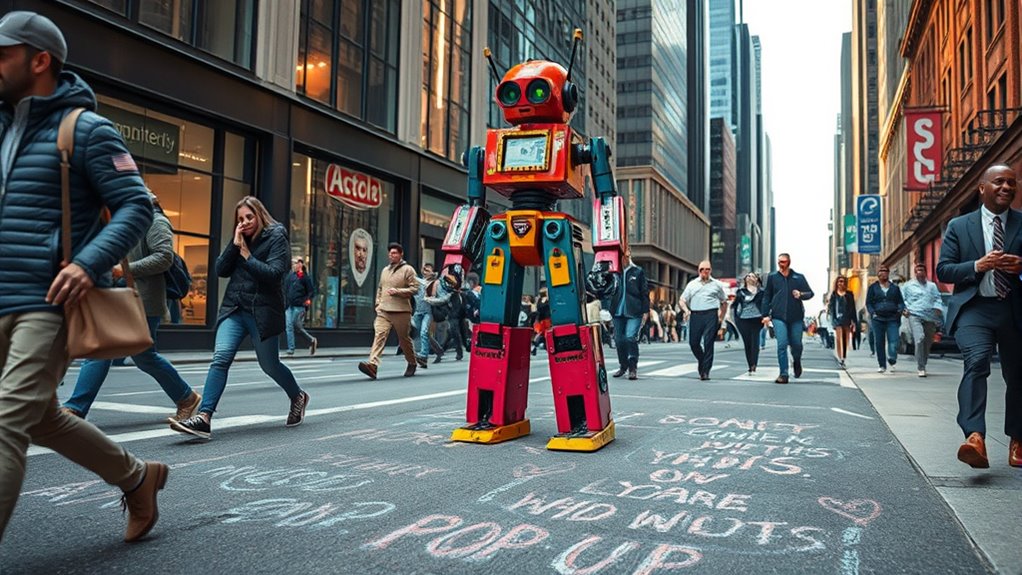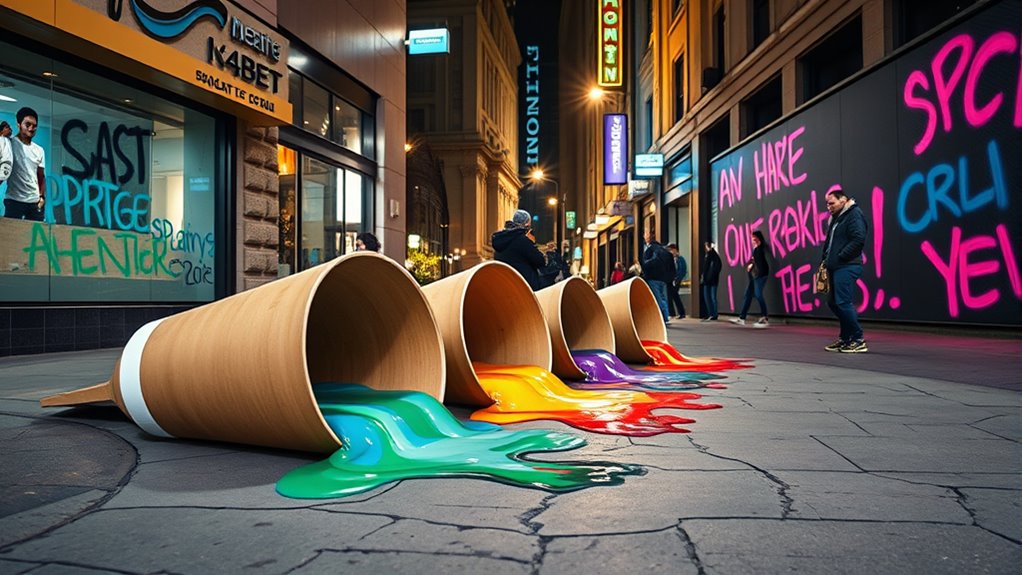Guerrilla marketing campaigns that feature bold street art and unexpected public interventions can quickly grab attention and go viral nationwide. These strategies transform ordinary spaces into engaging canvases, sparking curiosity and social sharing. By combining creativity, cultural relevance, and surprise, brands create memorable moments that generate headlines without huge budgets. If you want to see how these tactics turn ordinary environments into powerful storytelling tools, explore these impactful case studies further.
Key Takeaways
- Creative street art campaigns transformed urban spaces, capturing public attention and generating viral social media buzz nationwide.
- Low-cost guerrilla tactics, like unexpected murals, turned ordinary areas into memorable brand experiences that garnered headlines.
- Campaigns tied social issues or humor into visual art, resonating deeply and prompting organic media coverage.
- Surprising environmental modifications, such as transforming dull facades, increased engagement and shared online, sparking widespread interest.
- Innovative use of public spaces created cultural moments that elevated brand visibility and triggered national conversations.

Guerrilla marketing has revolutionized how brands capture attention with minimal budgets by leveraging creativity and unexpected tactics. It’s about thinking outside the box and making a memorable impact without relying on massive advertising spend. One of the most powerful tools in this approach is street art. When executed cleverly, street art transforms ordinary urban spaces into canvases that engage passersby and spark curiosity. For example, a brand might commission a mural that seems to interact with its surroundings or use public spaces for temporary installations that blend art with marketing messages. These installations don’t just promote; they create an experience that sticks with viewers, prompting them to share the images on social media, fueling viral campaigns.
Street art as a guerrilla tactic is especially effective because it combines visual appeal with surprise. When people encounter a striking piece of art unexpectedly, it grabs their attention instantly. This organic engagement often leads to online sharing, turning a simple mural into a viral campaign. Think about how certain murals or graffiti pieces suddenly become the talk of the town, not only because of their artistic quality but also because they cleverly tie into a brand’s message or campaign. This type of guerrilla marketing isn’t just about advertising; it’s about creating cultural moments that resonate widely. When done right, these street art projects can generate headlines and social media buzz, elevating the brand’s visibility far beyond traditional ads.
What makes these campaigns stand out is their authenticity and the element of surprise. You don’t expect a brand to turn a dull alleyway into a vibrant advertising space overnight, and that shock factor can be incredibly effective. When your street art becomes a viral campaign, it’s often not just because of the art itself but because it taps into current trends, social issues, or humor that encourages sharing. This organic spread amplifies your message without the need for costly media buys. As a result, you get the dual benefit of local engagement and national attention, often covered by news outlets and social media influencers.
In essence, street art-driven guerrilla marketing turns everyday environments into dynamic advertising platforms. When paired with clever storytelling and timely execution, these campaigns can ignite conversations, spark viral moments, and generate headlines that put your brand in the spotlight—all while keeping costs relatively low. It’s a testament to how creativity, when combined with strategic planning, can produce powerful, memorable marketing that resonates deeply and spreads widely. Furthermore, leveraging brand recognition through innovative street art can strengthen consumer trust and loyalty over time.
Frequently Asked Questions
How Do Guerrilla Marketing Campaigns Measure ROI Effectively?
When measuring ROI for guerrilla marketing campaigns, you focus on tracking conversions and measuring engagement. You set clear goals beforehand, like increased website visits or social media shares, then monitor how your audience interacts. Using tools like analytics platforms helps you see which tactics drive results. By comparing these metrics against your investment, you can determine your campaign’s effectiveness and optimize future efforts for better ROI.
What Legal Considerations Are Involved in Guerrilla Marketing Strategies?
Think of guerrilla marketing as walking a tightrope—you need to stay balanced. You must guarantee legal compliance by understanding local laws and securing necessary permissions. Protect your ideas by respecting intellectual property rights and avoiding copyright infringement. Failing to do so can lead to legal trouble that throws your campaign off course. Always double-check regulations and consult legal experts to keep your bold tactics within the law’s boundaries.
How Can Small Businesses Implement Guerrilla Tactics on a Budget?
You can implement guerrilla tactics on a budget by leveraging creative partnerships with local businesses or influencers, which amplifies your reach without high costs. Use social media integration to showcase your campaigns, encouraging sharing and engagement. Focus on eye-catching, memorable ideas that resonate with your audience. This approach helps you stand out, build community support, and maximize your marketing impact without overspending, making your small business more visible and memorable.
Which Industries Benefit Most From Guerrilla Marketing Efforts?
Think of industries like vibrant canvases that flourish with guerrilla marketing. You’ll find retail, entertainment, and hospitality thrive because they’re all about sparking brand awareness and igniting consumer engagement. These sectors can turn ordinary spaces into lively billboards, creating buzz that spreads like wildfire. By using unexpected tactics, they capture attention and foster memorable interactions, making guerrilla marketing a powerful tool to stand out in crowded markets.
What Are Common Mistakes to Avoid in Guerrilla Marketing Campaigns?
When planning your guerrilla marketing campaign, you want to avoid common pitfalls like viral pitfalls and branding blunders. Don’t overlook audience sensitivity or cultural differences, as these can backfire. Keep your message clear and authentic; otherwise, your efforts might seem gimmicky or misunderstood. Always test your ideas beforehand, and stay true to your brand voice. This way, you’ll maximize impact without risking reputation damage or losing public trust.
Conclusion
By studying these guerrilla marketing case studies, you see how bold, unconventional tactics can capture attention and generate buzz. Did you know that 84% of consumers say they’re more likely to remember a brand after engaging with a creative campaign? This proves that thinking outside the box not only sparks headlines but also leaves a lasting impression. So, when you’re planning your next campaign, remember that a little creativity can go a long way in making your brand unforgettable.











